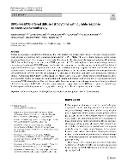DIPG-like MYB-altered diffuse astrocytoma with durable response to intensive chemotherapy

Author
Publication date
2023Published in
Child's Nervous SystemVolume / Issue
39 (9)ISBN / ISSN
ISSN: 0256-7040Metadata
Show full item recordCollections
This publication has a published version with DOI 10.1007/s00381-023-05976-3
Abstract
Pontine gliomas represent difficult to treat entity due to the location and heterogeneous biology varying from indolent low-grade gliomas to aggressive diffuse intrinsic pontine glioma (DIPG). Making the correct tumor diagnosis in the pontine location is thus critical. Here, we report a case study of a 14-month-old patient initially diagnosed as histone H3 wild-type DIPG. Due to the low age of the patient, the MRI appearance of DIPG, and anaplastic astrocytoma histology, intensive chemotherapy based on the HIT-SKK protocol with vinblastine maintenance chemotherapy was administered. Rapid clinical improvement and radiological regression of the tumor were observed with nearly complete remission with durable effect and excellent clinical condition more than 6.5 years after diagnosis. Based on this unexpected therapeutic outcome, genome-wide DNA methylation array was employed and the sample was classified into the methylation class "Low-grade glioma, MYB(L1) altered." Additionally, RT-PCR revealed the presence of MYB::QKI fusion. Taken together, the histopathological classification, molecular-genetic and epigenetic features, clinical behavior, and pontine location have led us to reclassify the tumor as a pontine MYB-altered glioma. Our case demonstrates that more intensive chemotherapy can achieve long-term clinical effect in the treatment of MYB-altered pontine gliomas compared to previously used LGG-based regimens or radiotherapy. It also emphasizes the importance of a biopsy and a thorough molecular investigation of pontine lesions.
Keywords
Chemotherapy, DIPG, MYB-altered glioma, MYB::QKI fusion, Pediatric pontine glioma
Permanent link
https://hdl.handle.net/20.500.14178/2096License
Full text of this result is licensed under: Creative Commons Uveďte původ 4.0 International







